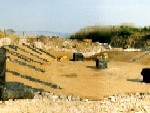 Although there has been very little published on this subject, it would seem likely that leachate recirculation in the form of pumping leachate from the base of a cell back up into the top of the waste has been practised in the past, and continues to be used, at the majority of landfills.
Although there has been very little published on this subject, it would seem likely that leachate recirculation in the form of pumping leachate from the base of a cell back up into the top of the waste has been practised in the past, and continues to be used, at the majority of landfills.
To the site operator this would seem like commonsense as some of the leachate recirculated will be absorbed by the waste and not re-appear. In addition, if leachate is being removed for treatment, the action of recirculation will assist the removal of leachate by reducing the peak flows. Flow during wet weather is smoothed by the delay which occurs, while the recirculated leachate percolates through the waste and before it re-appears at the base of the waste.
From the point of view of good leachate management, leachate recirculation in this form, while often likely to increase the strength of the recirculated leachate during each pass, will usually provide benefits, as follows:-
- When a cell is new, recirculation can accelerate waste settlement and stabilise the waste mass, and bring forward the start of methanogenesis and gas production. However, this has to be considered carefully and is likely to be the case as long as the recirculated leachate does not significantly cool the waste mass, does not cause complete saturation of the waste mass, or introduce excessive oxygen;
- Recirculation may help reduce the initial very high BOD/COD concentration seen during the acetogenic stage, which in turn reduces the oxygen demand on the aeration plant during treatment of leachate removed to a leachate treatment facility;
- As mentioned earlier, during wet weather periods, recirculation can temporarily “store” peak leachate flows, while they percolate through the waste and arrive again at a leachate collection point. This will allow the leachate treatment facility throughput, or maximum off-site tankerage rates to be smaller, and generally that will be more cost effective.
The method of leachate recirculation will require agreement with the site regulator. Nevertheless, recirculation has been practised on most landfill sites for periods during the “active” life of the landfill, and before capping each waste cell.
“Leachate recirculation, as discussed here, is not the sort which takes place in a bio-reactor landfill”
Leachate recirculation as described here has nothing to do with bioreactor landfills. This sort of recirculation is not “flushing” . Bioreactor landfills need the introduction of additional fresh water, or the recirculation of high quality treated Leachate, in order to achieve flushing-out of soluble contaminants in the waste.
Further Reading:
[DEAL_OF_THE_DAY]
